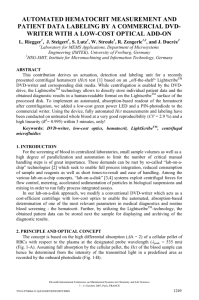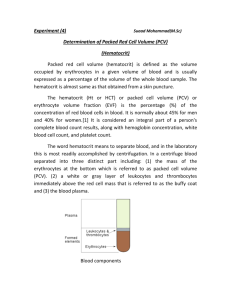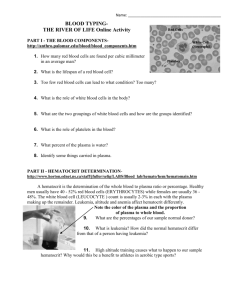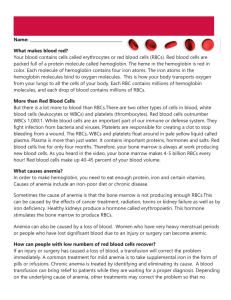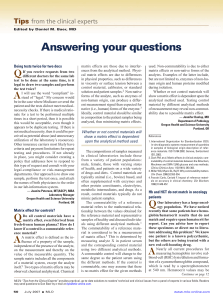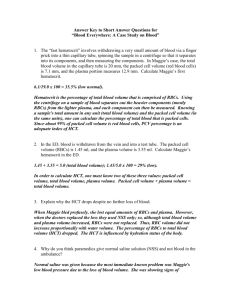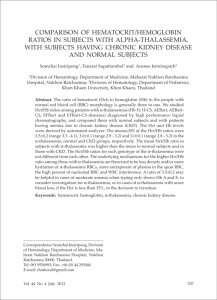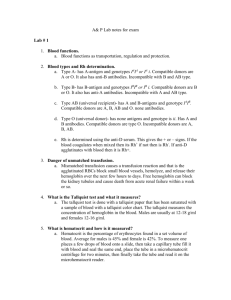Non-invasive measurement of blood hematocrit in artery
advertisement
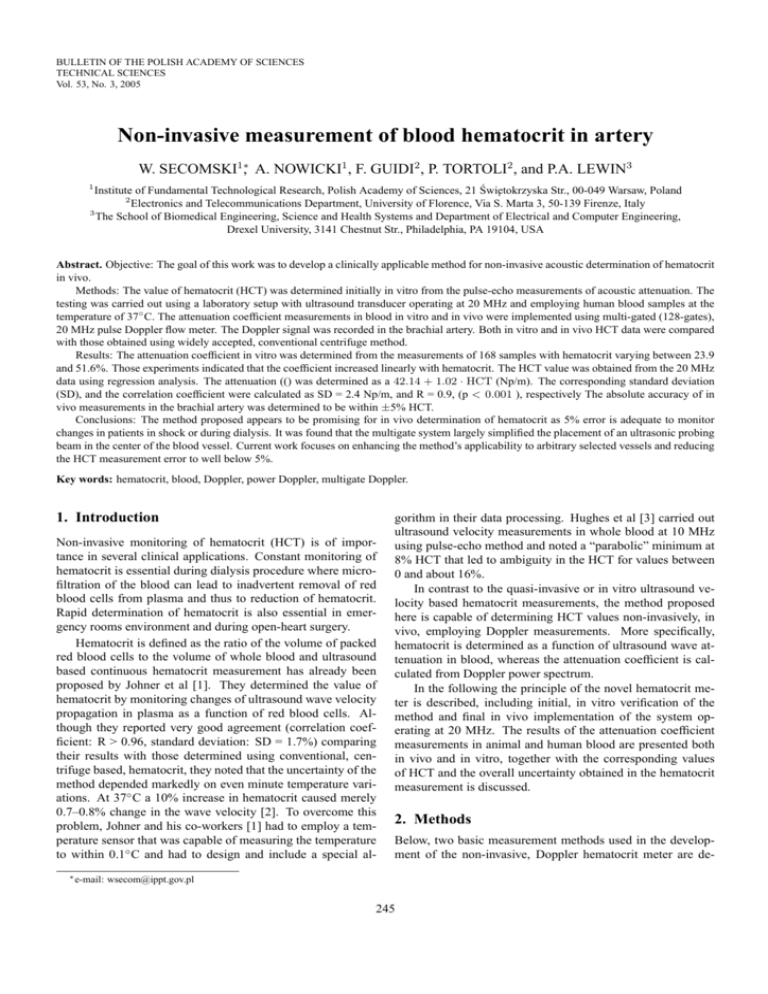
BULLETIN OF THE POLISH ACADEMY OF SCIENCES TECHNICAL SCIENCES Vol. 53, No. 3, 2005 Non-invasive measurement of blood hematocrit in artery W. SECOMSKI1∗, A. NOWICKI1 , F. GUIDI2 , P. TORTOLI2 , and P.A. LEWIN3 1 Institute of Fundamental Technological Research, Polish Academy of Sciences, 21 Świ˛etokrzyska Str., 00-049 Warsaw, Poland 2 Electronics and Telecommunications Department, University of Florence, Via S. Marta 3, 50-139 Firenze, Italy 3 The School of Biomedical Engineering, Science and Health Systems and Department of Electrical and Computer Engineering, Drexel University, 3141 Chestnut Str., Philadelphia, PA 19104, USA Abstract. Objective: The goal of this work was to develop a clinically applicable method for non-invasive acoustic determination of hematocrit in vivo. Methods: The value of hematocrit (HCT) was determined initially in vitro from the pulse-echo measurements of acoustic attenuation. The testing was carried out using a laboratory setup with ultrasound transducer operating at 20 MHz and employing human blood samples at the temperature of 37◦ C. The attenuation coefficient measurements in blood in vitro and in vivo were implemented using multi-gated (128-gates), 20 MHz pulse Doppler flow meter. The Doppler signal was recorded in the brachial artery. Both in vitro and in vivo HCT data were compared with those obtained using widely accepted, conventional centrifuge method. Results: The attenuation coefficient in vitro was determined from the measurements of 168 samples with hematocrit varying between 23.9 and 51.6%. Those experiments indicated that the coefficient increased linearly with hematocrit. The HCT value was obtained from the 20 MHz data using regression analysis. The attenuation (() was determined as a 42.14 + 1.02 · HCT (Np/m). The corresponding standard deviation (SD), and the correlation coefficient were calculated as SD = 2.4 Np/m, and R = 0.9, (p < 0.001 ), respectively The absolute accuracy of in vivo measurements in the brachial artery was determined to be within ±5% HCT. Conclusions: The method proposed appears to be promising for in vivo determination of hematocrit as 5% error is adequate to monitor changes in patients in shock or during dialysis. It was found that the multigate system largely simplified the placement of an ultrasonic probing beam in the center of the blood vessel. Current work focuses on enhancing the method’s applicability to arbitrary selected vessels and reducing the HCT measurement error to well below 5%. Key words: hematocrit, blood, Doppler, power Doppler, multigate Doppler. 1. Introduction Non-invasive monitoring of hematocrit (HCT) is of importance in several clinical applications. Constant monitoring of hematocrit is essential during dialysis procedure where microfiltration of the blood can lead to inadvertent removal of red blood cells from plasma and thus to reduction of hematocrit. Rapid determination of hematocrit is also essential in emergency rooms environment and during open-heart surgery. Hematocrit is defined as the ratio of the volume of packed red blood cells to the volume of whole blood and ultrasound based continuous hematocrit measurement has already been proposed by Johner et al [1]. They determined the value of hematocrit by monitoring changes of ultrasound wave velocity propagation in plasma as a function of red blood cells. Although they reported very good agreement (correlation coefficient: R > 0.96, standard deviation: SD = 1.7%) comparing their results with those determined using conventional, centrifuge based, hematocrit, they noted that the uncertainty of the method depended markedly on even minute temperature variations. At 37◦ C a 10% increase in hematocrit caused merely 0.7–0.8% change in the wave velocity [2]. To overcome this problem, Johner and his co-workers [1] had to employ a temperature sensor that was capable of measuring the temperature to within 0.1◦ C and had to design and include a special al∗ e-mail: gorithm in their data processing. Hughes et al [3] carried out ultrasound velocity measurements in whole blood at 10 MHz using pulse-echo method and noted a “parabolic” minimum at 8% HCT that led to ambiguity in the HCT for values between 0 and about 16%. In contrast to the quasi-invasive or in vitro ultrasound velocity based hematocrit measurements, the method proposed here is capable of determining HCT values non-invasively, in vivo, employing Doppler measurements. More specifically, hematocrit is determined as a function of ultrasound wave attenuation in blood, whereas the attenuation coefficient is calculated from Doppler power spectrum. In the following the principle of the novel hematocrit meter is described, including initial, in vitro verification of the method and final in vivo implementation of the system operating at 20 MHz. The results of the attenuation coefficient measurements in animal and human blood are presented both in vivo and in vitro, together with the corresponding values of HCT and the overall uncertainty obtained in the hematocrit measurement is discussed. 2. Methods Below, two basic measurement methods used in the development of the non-invasive, Doppler hematocrit meter are de- wsecom@ippt.gov.pl 245 W. Secomski, A. Nowicki, F. Guidi, P. Tortoli, and P.A. Lewin scribed. Both methods were initially employed to determine animal and human blood hematocrit in vitro. Based on the results of these measurements the Doppler hematocrit meter for in vivo, clinical applications was designed and its operation principles are also outlined in the following. 2.1. Pulse-echo method In vitro animal hematocrit measurements. In the first method used ultrasound attenuation was determined in vitro in animal blood following the transmission measurement approach detailed by Carstensen et al [2]. Yuan et al [4] reported that acoustic properties of animal blood, including scattering, are very similar to those exhibited by human one. This is consistent with the results published by Vandegriff et al [5] who found that animal and human blood cells have almost identical biochemical properties and physical dimensions and shape. Their findings were also confirmed by Standl et al [6] who proposed to use bovine blood as oxygen carrier in humans. Briefly, 2 ml, cylindrical blood sample container filled with porcine blood was placed between two unfocused, 20 MHz ultrasound transducers similar to the ones used in the final noninvasive Doppler hematocrit meter described in the following. The transducers were positioned in a well-known distance and one of the transducers operated as a transmitter and the other one as a receiver. The transmitter was excited by 8 cycles tone burst having 36 Vpp amplitude. (These excitation conditions were also employed later in non-invasive Doppler hematocrit meter described below). The amplitude of the received signal was expected to depend upon attenuation of the acoustic energy in blood and was first measured in distilled water to determine the reference level. The attenuation was determined at 20◦ C. The subsequent measurements were carried out in assays with HCT values ranging from 1% (plasma) to 65% ◦ Centrifuged red cells). The centrifuge measured HCT values were used to determine the reference level of hematocrit. 2.2. Doppler method. The attenuation was measured in vitro from the spectrum of the Doppler signal. The porcine blood moving at constant velocity in a flow phantom was investigated. In Fig. 1 the initial measurement system is shown. It employed a 2 gate pulsed ultrasound Doppler system operating at the frequency of 20 MHz to maximize Doppler frequency shift. During these studies the Doppler gates were positioned symmetrically around the axis of the plastic tube filled with moving blood. The power of the backscattered Doppler signal from the first and the second gate was determined from Eqs. (1) and (2), respectively, PQ1 = PT × T × η, (1) PQ2 = PT × T × η × e(−4αz) , (2) where PT denotes the transmitted acoustic power, T is equal to total loss of the signal between the transducer and the gate Q1, η denotes the backscattering coefficient of red blood cells, α is equal to the total acoustic pressure attenuation and z the axial distance between the two gates (see Fig. 1). From (1) and (2) attenuation coefficient α can be determined as: ln (PQ1 /PQ2 ) α= (3) 4z and hematocrit value can be then expressed as HCT = A × (α − α0 ) (4) where α0 is the acoustic attenuation in plasma and A is a constant determined from the linear regression analysis of the experimental data. As mentioned earlier, 20 MHz Doppler signal was chosen to maximize the sensitivity of the hematocrit meter. The 3 mm diameter, 20 MHz transducer was made of Lithium Niobate crystal and special attention was paid to ensure symmetric distribution of the field generated. In vitro human hematocrit measurements. A slightly modified method using one transducer operating in pulse-echo mode was also used. In this method the attenuation was determined at 37◦ C from the amplitude of the echoes reflected from the 3 mm dia stainless steel reflector positioned at 9.5 mm in the near field of the transducer. Human blood was drawn from 168 healthy volunteers; 30 women and 138 men, age 19– 54. To prevent coagulation K3 EDTA salt (No 366601, Becton Dickinson, Franklin Lakes, NJ, USA) was added. Samples of plasma were prepared using SST separation gel and clot activator (No 368986, Becton Dickinson, Franklin Lakes, NJ, USA). Reference hematocrit measurements were carried out on 168 different samples and five plasma samples using automatic HCT analyzer (K-4500, Sysmex, Long Grove, IL, USA). The measurements were carried out 4–8 hours after the blood was drawn. The samples were heated up to 37 ±0.5◦ C and poured over to the measurement chamber. The blood was constantly stirred to ensure a uniform distribution of red blood cells. Prior to each blood sample measurement, the chamber was carefully cleaned using distilled water. 246 Fig. 1. The principle of operation of the initial, two gate Doppler hematocrit Bull. Pol. Ac.: Tech. 53(3) 2005 Non-invasive measurement of blood hematocrit in artery Fig. 2. Distribution of the axially symmetric field generated by 20 MHz Doppler transducer; a) axial view; b) lateral view at 7 mm distance from the transducer This distribution is shown in Fig. 2; it was measured at the axial distances from the transducer surface ranging from 2–12 mm in 1 mm steps. Lateral distribution that was recorded from 0 to –14 dB levels in 2 dB intervals is also shown in Fig. 2. The measurements were carried out using 0.5 mm dia bilaminar hydrophone (Sonora Medical Systems, Longmont, CO, USA). As can be noticed the transducer produced axially symmetric uniform field distribution at the axial distance from 3 to 12 mm. Within this distance, the pulse-echo sensitivity measured in distilled water was determined to decrease by 6.9 Np/m. This value was then used to correct the in vivo data as the Doppler power spectrum signal attenuation in blood was on the same order. To further examine the Doppler approach, a multigate system with 128 gates was constructed. The tested porcine blood of various hematocrit flew within the plexiglas tube having an internal diameter equal to 6.4 mm. The peristaltic pump forced either continuous flow with constant velocity 15 cm/s or pulsatile flow with cyclic velocity variation between –16 cm/s and +68 cm/s. The distance between the axis of the tube and the transducer surface was 4.0 mm. In this way, the sampling volumes were located symmetrically. The value of hematocrit was determined from the ratios of the power Doppler spectra from the two sets of measurements corresponding to laminar and pulsatile flow. The average value of 100 spectra was used. 2.3. In vivo human hematocrit measurements. Based on the results of the 2 gate Doppler system measurements and to eliminate the dependence of the 2 gate system on the symmetry requirement a multigate Doppler system was designed. In Fig. 3 the principle of the multigate Doppler system designed to determine hematocrit in vivo is shown. The 128 gate Doppler system, including 128 channels custom designed FFT analyzer [7] was built to facilitate data collection at the axial distances ranging from 0–10 mm. The 128 Bull. Pol. Ac.: Tech. 53(3) 2005 gates ensured a sampling interval of approximately 0.075 mm. Doppler angle used during data collection was about 45 degrees. For each pulse transmitted at a given PRF rate, the multigate system digitized 128 complex samples. The operator could change the time interval between these samples, corresponding to the spacing between the range cells, in order to match the total analysed range to the region of interest. The processing system consists of an PCI-bus plug-in card [8] capable of digitizing, processing and storing 128 complex (range-gated) echoes backscattered along the beam axis of the 20 MHz probe. All needed electronics was included in a single board, equipped with a LabviewTM software package integrating time critical functions written in optimized C or assembly codes. Fig. 3. The principle of multigate Doppler system designed to determine hematocrit in vivo 247 W. Secomski, A. Nowicki, F. Guidi, P. Tortoli, and P.A. Lewin An array of Digital Signal Processors (TMS320C5xx by Texas Instruments) performed the processing task, which consisted of a 128-point FFT for each range-gated Doppler signal. The true spectra of the Doppler signals related to the 128 range cells were computed and displayed in real-time on the host Personal Computer (PC) monitor. During real-time operation, it was always possible to store in the hard disk all spectral profiles computed over a suitable time interval, for possible sequence replay or post-processing. hematocrit in %. Discrete data, including plasma, i.e. HCT = 0, are denoted by “o”; solid line represent the outcome of regression analysis. 3. Results In the following the results of the hematocrit measurements in vitro and in vivo are presented. In vitro data were obtained using pulse-echo method, whereas the in vitro blood flow phantom and in vivo data were obtained using the multigate (128 gates) Doppler system. 3.1. In vitro pulse-echo measurements of animal blood. The results presented below correspond to values of hematocrit ranging from 1% to 65%. In Fig. 4 attenuation in porcine blood measured using pulse-echo method at 20 MHz is plotted against hematocrit in %. Discrete data, are denoted by “o”; solid line represent the outcome of regression analysis. Fig. 5. Attenuation in human blood measured in vitro using pulseecho method at 20 MHz and at 37◦ C against hematocrit HCT, in % As shown in Fig. 5, at 20 MHz attenuation increases linearly with increasing HCT according to relationship: α = 42.14 + 1.025 × HCT (Np/m) (6) The corresponding correlation coefficient was calculated as R = 0.9, p < 0.001, n = 168 and standard deviation was determined to be 2.4 Np/m. These values were obtained taking into account attenuation in water and using the value of 6.45 Np/m at 20 MHz [9]. From (6), the hematocrit for human blood is calculated as: HCT = 0.976 × (α − 42.14) Fig. 4. Attenuation in porcine blood measured in vitro using pulseecho method at 20 MHz and at 20◦ C against hematocrit HCT (in %) As shown in Fig. 4, at 20 MHz attenuation increases linearly with increasing HCT according to relationship: α = 35.76 + 1.278 × HCT (Np/m) (5) The corresponding correlation coefficient was calculated as R = 0.987, n = 15. These values were obtained taking into account attenuation in water and using the value of 10.0 Np/m at 20 MHz and 20◦ C [9]. 3.2. In vitro pulse-echo measurements of human blood. The results presented below correspond to values of hematocrit ranging from 0% (plasma) to 80% (blood cells separated by SST separation gel). In Fig. 5 attenuation in human blood measured using pulse-echo method at 20 MHz is plotted against 248 (7) 3.3. In vitro Doppler measurements of animal blood. In vitro measurements of hematocrit were performed on the flow phantom. The flow was forced by peristaltic pump. The porcine blood assays ranging from 3–72% HCT. For each hematocrit sample 100 sets of Doppler spectra were recorded, each set being related to all of 128 gates across the vessel. After the spectra were acquired, the data were processed using MatLab(tm) software (The MathWorks, Natick, MA, USA). For each spectrum recorded in each gate, the power of the flow signal was calculated and Doppler power profile DPP (the distribution of the Doppler power across the vessel diameter) was obtained. The DPP data were used to calculate the value of hematocrit. The averaged linear regression was calculated from the DPP curve. The slope of the regression line divided by 4 is equal to the attenuation coefficient (Eq. 3). The DPP data were used to calculate the value of hematocrit. Next, all measurements were averaged to yield the final value of hematocrit. The results are presented in Fig. 6. Bull. Pol. Ac.: Tech. 53(3) 2005 Non-invasive measurement of blood hematocrit in artery Fig. 6. Comparison of the results obtained using conventional hematocrit centrifuge and multigate Doppler method for porcine blood; a) constant velocity blood flow; b) pulstile flow The correlation coefficient was R = 0.999 for continuous flow and R = 0.992 for pulsatile flow. The standard deviation was SD = 0.75 Np/m and SD = 2.75 Np/m respectively. The absolute accuracy of Doppler measurements were ±15% HCT for continuous flow and ±4.9% HCT for pulsatile flow. 3.4. In vivo Doppler measurements. In vivo measurements of hematocrit were performed on radial artery in 9 volunteers. The hematocrit values varying from 36.4% to 47.4%. For each volunteer 250 sets of Doppler spectra were recorded, each set being related to all of 128 gates across the vessel. The recording was done over a period of 2.5s; that corresponded to 2 heart cycles. After the spectra were acquired, the data were processed and Doppler power profile DPP was calculated. The hematocrit value in vivo was calculated from the Eq. 6. The results are presented in Fig. 7. The correlation coefficient was R = 0.986, n = 9. The absolute accuracy of Doppler in-vivo measurements in brachial artery were not more than 4.7% HCT. The determined error was always positive, the Doppler measurement was always overestimated. 4. Discussion and conclusions The results of in vitro pulseecho measurements demonstrated that the hematocrit value at 20 MHz increases linearly with increasing attenuation. These measurements also indicated that maximum backscattering observed at HCT value of 25% [4] had negligible influence on the measured attenuation. The standard deviation (SD) in attenuation coefficient measurement was determined to be equal to 2.4 Np/m. This value indicated that the overall uncertainty in the HCT measurement was approximately ±3.5%. This compares favorably with the ±5% uncertainty valid for in vivo data (see previous section and below) providing the measurements were carried out on brachial artery. In vitro Doppler measurements of HCT – Measurements of hematocrit in vitro using multigate Doppler system prototypes confirmed the high correlation ratio to reference, centrifuge method. In vivo Doppler measurements of human blood HCT – The results of the measurements in vivo demonstrated that hemotocrit could be non-invasively determined in brachial artery to within error of 5% using the Doppler method described; such error is clinically acceptable. Also, it should be pointed out that the multiple gates Doppler circuitry was essential in vivo measurements to eliminate the influence of the lateral movement of the vessel measured. The 128 gates system developed here allowed this error to be minimized by excluding the measurements influenced by the attenuation within the vessel wall and through averaging of the data acquired from multiple gates. In conclusion, a new, non-invasive, clinically applicable, 20 MHz pulsed Doppler ultrasound hematocrit meter was described. The transcutaneously operating device was initially tested in laboratory environment and its performance was verified subsequently in clinical environment. It was found that the multigate system largely simplified the placement of an ultrasonic probing beam in the centre of the blood vessel. Although the ±5% uncertainty is clinically acceptable and considered adequate to monitor changes in patients in shock or during dialysis, the method’s applicability to arbitrarily selected vessels is being examined and the work is underway to reduce the HCT measurement error to well below 5%. Acknowledgements. This work was supported by the Polish State Committee for Scientific Research grant KBN 5T07B03225. R EFERENCES Fig. 7. Comparison of the results obtained using automatic hematocrit analyzer and multigate Doppler method in vivo in the brachial artery Bull. Pol. Ac.: Tech. 53(3) 2005 [1] C. Johner, P. Chamney, D. Schneditz, and M. Krämer, “Evaluation of an ultrasonic blood volume monitor”, Nephrol. Dial. Transplant. 13, 2098–2103 (1998). [2] E. Carstensen and H. Schwan, “Acoustic properties of hemoglobin solutions”, J. Acoust. Soc. Am. 31, 305–311 (1959). 249 W. Secomski, A. Nowicki, F. Guidi, P. Tortoli, and P.A. Lewin [3] D. Hughes, L. Geddes, C. Babbs, J. Bourland, and V. Newhouse, “Attenuation and speed of 10 MHz ultrasound in canine blood of various packed-cell volumes at 37◦ C”, Med. Biol. Eng. Comput. 17, 619–622 (1979). [4] Y. Yuan and K. Shung, “Ultrasonic backscatter from flowing whole blood. I: dependence on shear rate and hematocrit”, J. Acoust. Soc. Am. 84, 52–58 (1988). [5] K. Vandegriff, M. McCarthy, R. Rohlfs, and R. Winslow, “Colloid osmotic properties of modified hemoglobins: chemically cross-linked versus polyethylene glycol surface-conjugated”, Biophys. Chem. 69, 23–30 (1997). [6] T. Standl, M. Burmeister, E. Horn, S. Wilhelm, W. Knoefel, 250 and J. Esch, “Bovine haemoglobin-based oxygen carrier for patients undergoing haemodilution before liver resection”, Brit. J. Anaesth. 80, 189–194 (1998). [7] P. Tortoli, F. Guidi, G. Guidi, and C. Atzeni, “Spectral velocity profiles for detailed ultrasound flow analysis”, IEEE Trans. Ultrason. Ferroelect. Freq. Contr. 43, 654–659 (1996). [8] F. Guidi, G. Guidi, S. Ricci, C. Atzeni, and P. Tortoli, “Highspeed parallel processing of biomedical ultrasound signals”, Proc. of the Second European DSP Education and Research Conference, Parigi, 327–330 (1998). [9] F. Duck, Physical Properties of Tissue, A Comprehensive Reference Book, Academic Press, London, New York, 1990. Bull. Pol. Ac.: Tech. 53(3) 2005
